THE CLASSIC HORROR FILM
By Jeffrey-Baptiste Tarlofsky
By Jeffrey-Baptiste Tarlofsky
Lesson 17 consists of 8 video lectures and transcripts of those lectures, and 7 film excerpts. Start with the lecture, Part 1, and continue down the page in sequence until you reach the end of the lesson.
レッスン17は8本のビデオレクチャー(レクチャーのテキストがビデオレクチャーの下に記載されています)と7本の動画で構成されています。
このレッスンは、ページをスクロールダウンしながら最初から順番に動画を見たりテキストを読んでください
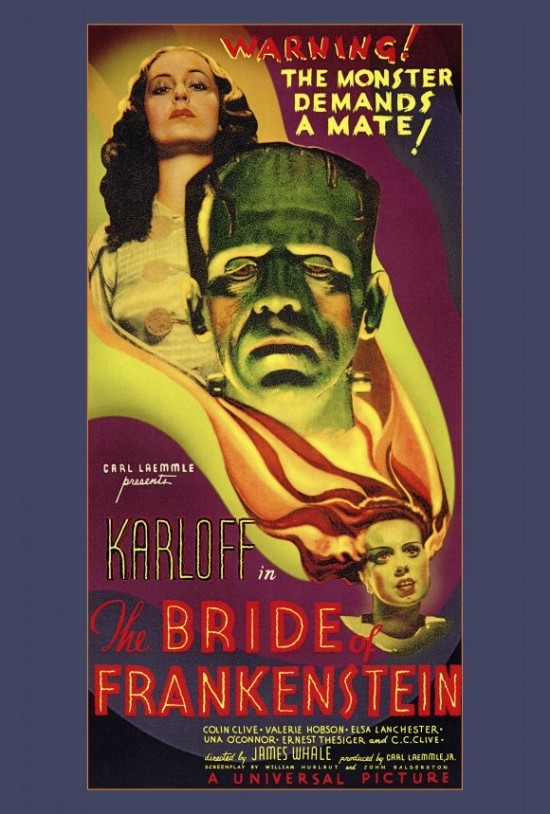
Directed by James Whalt
Produced by Carl Laemmle Jr.
Story by William Hurlbut and John L. Balderston
Starring Boris Karloff, Colin, Clive, Valerie Hobson, Elsa Lanchester, Ernest Thesiger, E.E. Clive
Budget: $397,000
Running Time: 75 minutes
Of course, it was the Frankenstein monster that made Boris Karloff a star and it would be the monster he would once again play in the sequel. It is around this time that people began to become confused and call the monster “Frankenstein” when, in fact, that is the name of the man who created the monster who still remains nameless in the film.


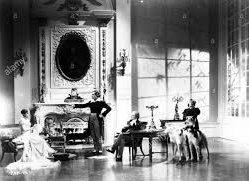
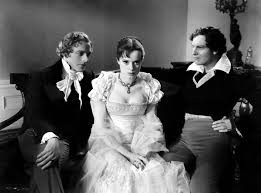
But you are probably wondering how it is possible for Karloff to play the monster again when the monster died in the original film? The writers devised a rather ingenious way around this by appealing to no less an authority than Mary Shelley herself. In the opening scene of the film, Mary Shelley, her husband Percy, and Lord Byron are at Byron’s Chateau in Switzerland. It is the year 1818, famous for being “the year without a summer” because the entire summer remained cold and wet with storms such as the one we see in the film. This is what forced Byron’s houseguests to stay indoors and devise a way to entertain themselves. They had a contest to see who could write the most frightening ghost story. Mary Shelley came up with the idea for her novel Frankenstein at this time.
Part 2
Sequels are continuations of the story in the original film, but many of them are set years after the original events of the film. Not The Bride of Frankenstein. The film begins almost exactly at the point where the original film ended, with the burning windmill. Immediately we are aware of the different tone being set in this film. Far from the grim and murderous determination of the mob in the original film, the mob in the sequel seems to regard the burning of the monster as a reason for celebration, especially the comical female servant from the Frankenstein household who rejoices at the monster’s death.
We learn very quickly that the monster was not actually burned in the mill but was saved when the mill collapsed into a deep well beneath the mill. The monster immediately takes his revenge on one of the villagers who is supposed to be little Maria’s father (notice that the actor has been changed)
This is all great fun, but any true fear the audience might experience is immediately canceled by the performance of the comical servant. So, is this a horror film or a comedy? It turns out to be about 75% horror with the rest being played as comedy. Hollywood had explored this combination before in London After Midnight. Personally, I have usually found comedy to spoil the effect of horror. To me, it is like adding orange juice to champagne. You can make something that tastes good this way…but why waste good champagne when it tastes better without orange juice?
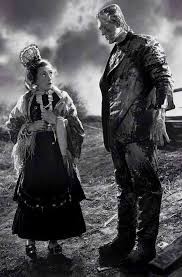
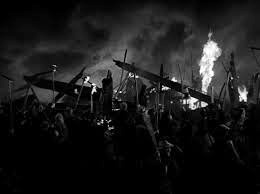
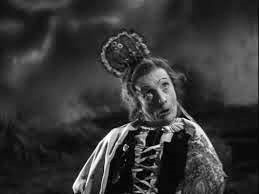
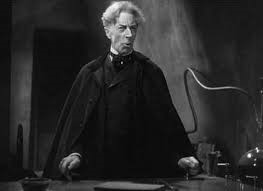 Part 3 – By far the most colorful addition in the film is the character Dr. Pretorius, played brilliantly by James Whale’s friend and former teacher, Ernst Thesinger. Before we discuss Thesinger’s Pretorius, I should say a word about Colin Clive at this point. James Whale had worked with Clive in a film called Journey’s End which was a serious drama about World War One. Whale respected Clive’s acting for the seriousness he brought to the part he played in that film so when it came time to cast the lead in Frankenstein, Whale turned to this actor to bring a similar seriousness to the Frankenstein character. Clive does this in the first film wonderfully (remember him talking about discovering the mysteries of the universe?). Clive is the star of Frankenstein…until Boris Karloff walks through the door and walks off with the movie. Few actors could have held their own with Karloff in the role of the monster. Clive’s Frankenstein was a serious character, but Karloff’s monster was a tragic one. Tragedy trumps seriousness. Is there anything that trumps tragedy? We will soon see.
Part 3 – By far the most colorful addition in the film is the character Dr. Pretorius, played brilliantly by James Whale’s friend and former teacher, Ernst Thesinger. Before we discuss Thesinger’s Pretorius, I should say a word about Colin Clive at this point. James Whale had worked with Clive in a film called Journey’s End which was a serious drama about World War One. Whale respected Clive’s acting for the seriousness he brought to the part he played in that film so when it came time to cast the lead in Frankenstein, Whale turned to this actor to bring a similar seriousness to the Frankenstein character. Clive does this in the first film wonderfully (remember him talking about discovering the mysteries of the universe?). Clive is the star of Frankenstein…until Boris Karloff walks through the door and walks off with the movie. Few actors could have held their own with Karloff in the role of the monster. Clive’s Frankenstein was a serious character, but Karloff’s monster was a tragic one. Tragedy trumps seriousness. Is there anything that trumps tragedy? We will soon see.
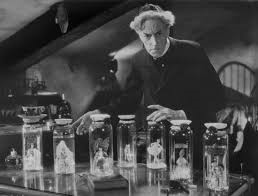 Part 4 – Pretorius is as much a seeker after the mysteries of the universe as Frankenstein, but while Frankenstein does so out of high-minded seriousness, Pretorius’ curiosity seems to be more that of a mischievous schoolboy. The two men are a series of contrasts. Frankenstein is the son of a baron and lives in a castle, while Pretorius is obviously poor. Pretorius is an old, disgraced professor, while Frankenstein is a young, brilliant student. As a German nobleman, Frankenstein’s family would naturally be a Christian (though, as we know, Frankenstein, does not respect the rules of religion). Pretorius appears to be Jewish because he is wearing a traditional Jewish skullcap. But obviously the biggest contrast between them is that Clive’s Frankenstein continues to be serious while Thesinger “camps it up” (to act with exaggerated speech or gestures or behave in an affected manner) throughout the film. This scene is pure camp with Frankenstein even commenting “this isn’t science” …it also isn’t horror, it’s pure camp comedy.
Part 4 – Pretorius is as much a seeker after the mysteries of the universe as Frankenstein, but while Frankenstein does so out of high-minded seriousness, Pretorius’ curiosity seems to be more that of a mischievous schoolboy. The two men are a series of contrasts. Frankenstein is the son of a baron and lives in a castle, while Pretorius is obviously poor. Pretorius is an old, disgraced professor, while Frankenstein is a young, brilliant student. As a German nobleman, Frankenstein’s family would naturally be a Christian (though, as we know, Frankenstein, does not respect the rules of religion). Pretorius appears to be Jewish because he is wearing a traditional Jewish skullcap. But obviously the biggest contrast between them is that Clive’s Frankenstein continues to be serious while Thesinger “camps it up” (to act with exaggerated speech or gestures or behave in an affected manner) throughout the film. This scene is pure camp with Frankenstein even commenting “this isn’t science” …it also isn’t horror, it’s pure camp comedy.
But what has become of the monster? He has been captured by the villagers but manages to escape only to be shot and badly wounded. He wanders into the forests where he eventually finds someone who will change his life.
 Part 5 – The scene with the blind man in which both he and the monster are in tears is also camp, but there is an underlying seriousness to what is happening. Like Maria, the little girl who gave the monster a flower and taught him how to play, the blind man does not judge the monster by his ugliness. Like little Maria, the blind man is lonely and wants a companion. He recognizes the loneliness of the monster because of his own loneliness. It reminds us again that the monster always reacts to how he is treated by others. Because the blind man treats him as a friend, the monster returns his friendship. Just as Maria taught the monster how to play, the blind man teaches the monster how to speak and also teaches him that it is bad to be alone. These two probably could have been together for many happy years, but again, the monster is misjudged by those who are frightened of him and he loses his friend. He wanders for a time and then finds himself back in the very same cemetery where Frankenstein and Fritz stole the body in the first scene of the first film. He breaks into the underground catacombs to hide from the villagers chasing him, but he finds someone else already there.
Part 5 – The scene with the blind man in which both he and the monster are in tears is also camp, but there is an underlying seriousness to what is happening. Like Maria, the little girl who gave the monster a flower and taught him how to play, the blind man does not judge the monster by his ugliness. Like little Maria, the blind man is lonely and wants a companion. He recognizes the loneliness of the monster because of his own loneliness. It reminds us again that the monster always reacts to how he is treated by others. Because the blind man treats him as a friend, the monster returns his friendship. Just as Maria taught the monster how to play, the blind man teaches the monster how to speak and also teaches him that it is bad to be alone. These two probably could have been together for many happy years, but again, the monster is misjudged by those who are frightened of him and he loses his friend. He wanders for a time and then finds himself back in the very same cemetery where Frankenstein and Fritz stole the body in the first scene of the first film. He breaks into the underground catacombs to hide from the villagers chasing him, but he finds someone else already there.
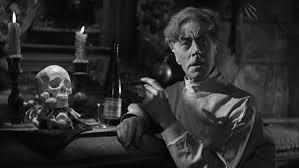 Part 6 – Dr. Pretorius is busy having his men steal dead bodies from the tombs beneath the cemetery but decides to stay and have a picnic, (this guy is really weird). The monster approaches him, but Pretorius, like Maria and the blind man, is completely unafraid of the monster. In a way, Pretorius is almost as innocent as either Maria or the blind man because he refuses to take anything very seriously, including the danger from the monster. Playing the part of Pretorius, Ernst Thesinger gayly camps his way through this scene and it answers our question; “does anything trump tragedy?” Yes, camp does. It is impossible for us to feel the monster’s tragedy while Pretorius is busy feeding him cigars and gin. By playing Pretorius as a camp character, Ernst Thesinger was able to do what Colin Clive was unable to do in either of the films, hold his own with Boris Karloff. Boris Karloff never once steals a scene from Thesinger…in fact, it is actually the reverse in this scene.
Part 6 – Dr. Pretorius is busy having his men steal dead bodies from the tombs beneath the cemetery but decides to stay and have a picnic, (this guy is really weird). The monster approaches him, but Pretorius, like Maria and the blind man, is completely unafraid of the monster. In a way, Pretorius is almost as innocent as either Maria or the blind man because he refuses to take anything very seriously, including the danger from the monster. Playing the part of Pretorius, Ernst Thesinger gayly camps his way through this scene and it answers our question; “does anything trump tragedy?” Yes, camp does. It is impossible for us to feel the monster’s tragedy while Pretorius is busy feeding him cigars and gin. By playing Pretorius as a camp character, Ernst Thesinger was able to do what Colin Clive was unable to do in either of the films, hold his own with Boris Karloff. Boris Karloff never once steals a scene from Thesinger…in fact, it is actually the reverse in this scene.
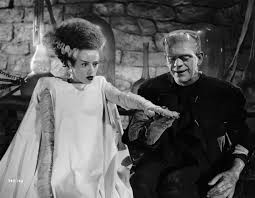 But to return to our serious themes: In the first film, Frankenstein gave the monster light and then took it away. It is from that moment on that he loses control of the monster because he is denying him what he needs and desires. As every critic has said of both the novel and the film, Frankenstein rejects his own creation. Pretorius does the opposite. Pretorius embraces the monster (because he is useful) and guesses that the monster now needs a mate. Pretorius offers to create a woman monster to be his companion, just as God created Eve to be a companion for Adam. The only problem is, Pretorius cannot do this without Frankenstein’s help.
But to return to our serious themes: In the first film, Frankenstein gave the monster light and then took it away. It is from that moment on that he loses control of the monster because he is denying him what he needs and desires. As every critic has said of both the novel and the film, Frankenstein rejects his own creation. Pretorius does the opposite. Pretorius embraces the monster (because he is useful) and guesses that the monster now needs a mate. Pretorius offers to create a woman monster to be his companion, just as God created Eve to be a companion for Adam. The only problem is, Pretorius cannot do this without Frankenstein’s help.
In Shelley’s novel, there is no Dr. Pretorius, but the monster does learn how to speak and also learns how to read. By reading the Bible, the monster learns the story of God’s creation, Adam. He tells Frankenstein that if he had not rejected him the monster could have been his Adam, but because Frankenstein did reject him the monster promises to become Frankenstein’s Lucifer. However, in the novel, the monster offers to leave Frankenstein in peace if he will only make a mate for him. In the film, however, Dr. Pretorius takes on the role of Lucifer in the garden of Eden, (recall that when Pretorius shows Frankenstein his miniatures, one of them resembles Satan and Pretorius muses that he “rather resembles me, don’t you think?”). Pretorius, like Lucifer, offers the still innocent monster the fruit of (sexual) knowledge by offering to create a woman for him.
If the first film was about showing the monster as a newborn life so innocent he is almost infantile, the second film shows his struggles through early childhood on through adolescence. In many ways, the second film is the story of the monster as an alienated adolescent. What teenager has not been misunderstood by the adults around him, had difficulties communicating what he really means or wants, and been misunderstood, misjudged, and unjustly punished? Most importantly, what teenager has not felt the stirrings of the need for romantic love?
Part 7 – You can think of the relationships between Frankenstein, Pretorius, and the monster as being like rock, paper, and scissors: Frankenstein refuses Pretorius’s demand for help with his experiment, Pretorius gains control over the monster, and the monster forces Frankenstein to assist Pretorius with his experiment.
Clearly, the monster relishes telling Frankenstein to “sit down”. The shoe, as they say, is on the other foot. But Frankenstein cannot be intimidated by the monster’s direct threats. It is only when Elizabeth (by the way, you noticed they changed the actress playing Elizabeth, didn’t you?) is kidnapped that Frankenstein agrees to Pretorius’s demands. They then set about assembling the new monster in Frankenstein’s old laboratory (which has been considerably upgraded since the first movie). As you will see in the next excerpt, the creation of the second monster involves even more fun than it did in the first movie. James Whale uses every weird angle and shadow that he can to create a scene which, while camp, is also an expressionist tour de force (a particularly adroit maneuver or technique in handling a difficult situation). It is magnificent.
 Part 8 – As I said earlier, what adolescent has not felt the need for romantic love? Similarly, what adolescent has not had to deal with the heartbreak of rejection? After all the trouble Frankenstein and Pretorius go to in order to create a female monster to be his mate, as soon as the new woman monster sees the monster she rejects him! Rejected by his own creator, rejected by society, and now rejected by his one prospect at love, the monster now chooses to commit suicide taking Pretorius and the monster with him, but curiously letting Frankenstein go.
Part 8 – As I said earlier, what adolescent has not felt the need for romantic love? Similarly, what adolescent has not had to deal with the heartbreak of rejection? After all the trouble Frankenstein and Pretorius go to in order to create a female monster to be his mate, as soon as the new woman monster sees the monster she rejects him! Rejected by his own creator, rejected by society, and now rejected by his one prospect at love, the monster now chooses to commit suicide taking Pretorius and the monster with him, but curiously letting Frankenstein go.
In the first film, Whale and his writers ended the film by showing the monster dying in the windmill, which made him seem to be a Christ figure, but in the second film, the monster is shown to be much more like the rest of us with all our troubles getting along with other human beings and trying to find someone we can love and who will love us in return.
 The critics have often called The Bride Of Frankenstein an even better movie than the original Frankenstein. I think this is because the style in The Bride Of Frankenstein is so wonderful, but for me, the story is simply not even close to being as interesting or important as that of the original and as much as I enjoy the campiness of the second film, it is the first film that deals with the great mysteries and is the better film.
The critics have often called The Bride Of Frankenstein an even better movie than the original Frankenstein. I think this is because the style in The Bride Of Frankenstein is so wonderful, but for me, the story is simply not even close to being as interesting or important as that of the original and as much as I enjoy the campiness of the second film, it is the first film that deals with the great mysteries and is the better film.
But let me add that one can and should enjoy both films for what they are.
The success of this first horror sequel also inspired the studio to return to the Dracula story in 1936 with another sequel called Dracula’s Daughter. This film, too, was profitable for Universal.
And now I leave you with a mystery. Given the success of these first two sequels to Frankenstein and Dracula, why did Universal Studios stop making any horror films at all from the end of 1936 to 1939? I will solve this mystery for you in the next lesson.